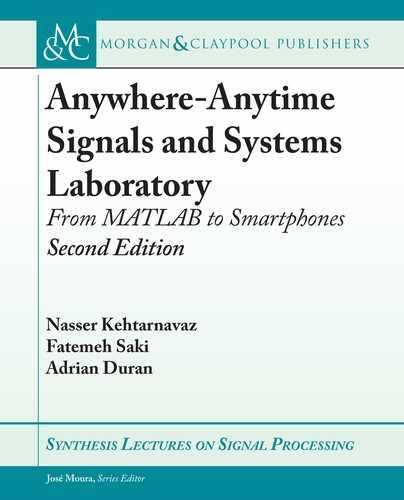
134 5. FOURIER SERIES
Figure 5.7: Plot of periodic x.t/. Figure 5.8: Plot of Ox.t/ or reconstructed
x.t/.

5.2. FOURIER SERIES AND ITS APPLICATIONS 135
Figure 5.9: Plot of the error between x.t/ and Ox.t/.

136 5. FOURIER SERIES
L5.2 – LINEAR CIRCUIT ANALYSIS USING THE TRIGONOMETRIC
FOURIER SERIES
In this example, linear circuit analysis is performed using the trigonometric Fourier series. e
ability to decompose any periodic signal into a number of sine waves makes the Fourier series
a powerful tool in electrical circuit analysis. e response of a circuit component when a si-
nusoidal input is applied to its terminals is well known in circuit analysis. us, to obtain the
response to any periodic signal, one can decompose the signal into sine waves and perform a
linear superposition of the sine waves.
Consider a simple RC circuit excited by a periodic input signal, as shown in Figure 5.10.
V
in
(t)
C = 1F
R = 1 Ω
Figure 5.10: RC series circuit with periodic input voltage.
Open MATLAB (version 2015b or a later version), start a new MATLAB script in the HOME
panel, and select a New Script. Write a MATLAB code to determine the Fourier series coeffi-
cients of the input voltage signal as discussed in the previous example. Because a Fourier series
involves the sum of sinusoids, phasor analysis can be used to obtain the output voltage .v
c
/.
Let n represent the number of terms in the Fourier series. By using the voltage divider rule, the
output voltage .v
c
/ can be expressed as [1]:
v
c_n
D
1=.j n!C /
R C 1=.j n! C /
v
i n_n
: (5.18)
Because the sine and cosine components of the input voltage are known, one can easily
determine the output by adding the individual output components noting that the circuit is
linear. Determine each component of the output voltage by using Equation (5.18). Save the
script using the name L5_2; see Figure 5.11. Next, write a test script for verification purposes.
Open a New Script, write your verification code and save it using the name L5_2_testbench as
shown in Figure 5.12.
Run L5_2_testbench for different resistance, capacitance, A , T , w , and N values and
observe the results. Follow the steps as outlined in lab L3_1 to generate the corresponding C
code and then place it into the shell provided. Figure 5.13 shows the app screen on an Android
smartphone. Enter values for Delta , A , T , w , and N , select the input signal and the desired
output signal to be plotted, then press COMPUTE. Figures 5.14 through 5.20 show a
n
, b
n
,
peridodic signal x.t/, VCcos_m (magnitude of the cosine components), VCcos_a (phase of the
cosine components), VCsin_m (magnitude of the sine components), VCsin_a (phase of the sine

5.2. FOURIER SERIES AND ITS APPLICATIONS 137
Figure 5.11: L5_2 function for circuit analysis with trigonometric Fourier series.

138 5. FOURIER SERIES
Figure 5.12: L5_2_testbench.
..................Content has been hidden....................
You can't read the all page of ebook, please click here login for view all page.
